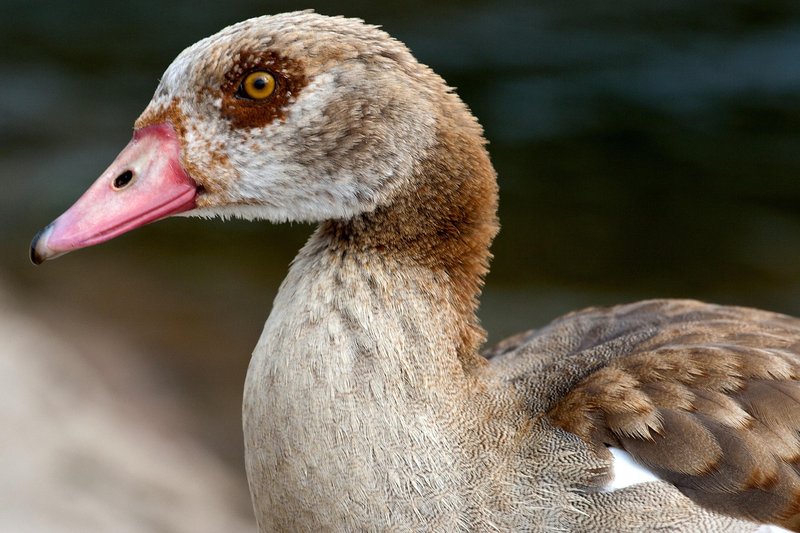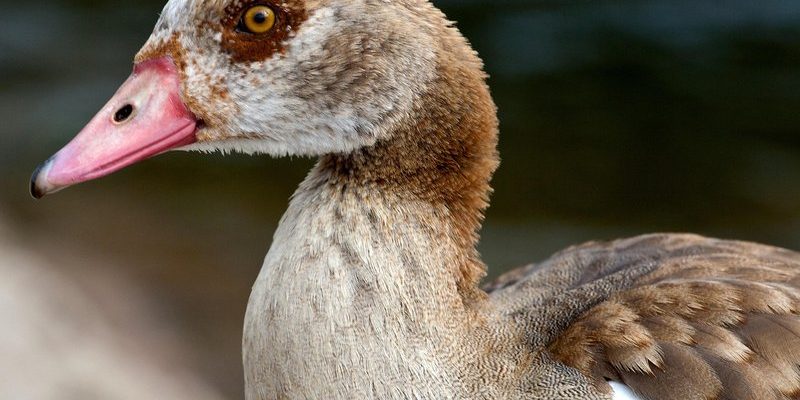
The Egyptian Goose is a striking bird that captures the curiosity of many nature enthusiasts. With its distinctive appearance and unique behaviors, it stands out in the avian world. Imagine walking by a serene lake, the sun glinting off the water, and suddenly spotting a plump, colorful bird paddling elegantly. That’s the Egyptian Goose for you!
Believed to have originated from the Nile region, the Egyptian Goose isn’t just beautiful; it’s also rich in history and culture. Revered by ancient Egyptians, these birds were thought to represent fertility and were often depicted in their art. Today, their presence spans various continents beyond Africa, showing just how adaptable they can be.
Physical Characteristics
The Egyptian Goose is medium-sized, typically ranging from 60 to 75 cm in length. One of its most charming features is the bright chestnut-colored wings contrasted with the paler body. The feathers are accentuated by a striking dark patch around the eyes. This bird’s unique combination of colors makes it easily identifiable, even from a distance.
Another interesting aspect is its sexual dimorphism. Males and females are similar in appearance, but the males are generally larger and more robust. Both sexes have a distinctive “eyebrow” marking that adds to their charm. Young Egyptian Geese are notably different, sporting a more muted palette with less vivid markings, which helps them blend into their surroundings.
When it comes to their beaks, they are also quite distinctive. The beaks are a rich pink color, which stands out against their plumage. This adds an additional layer of personality to the Egyptian Goose. Whether you’re on a casual stroll or a dedicated birdwatching trip, their bright appearance and engaging behaviors are sure to catch your eye!
Habitat and Range
Egyptian Geese thrive in a variety of habitats, from wetlands and lakes to rivers and grasslands. Their preferred environment includes open water bodies surrounded by grassy areas where they can forage. This flexibility in habitat choice has allowed them to spread beyond Africa to parts of Europe and Asia.
Interestingly, they are often found in urban parks and golf courses, showcasing their adaptability to human-altered landscapes. This trend isn’t just charming; it speaks volumes about how well the Egyptian Goose can thrive amidst various environments. It’s almost as if they’re saying, “We can make this work!”
While they are predominantly found in regions close to water, they can also travel considerable distances in search of food or suitable nesting sites. Their ability to adapt to both natural and urban settings allows them to survive in diverse ecosystems, making them a resilient species in many areas.
Diet and Feeding Habits
When it comes to food, Egyptian Geese are primarily herbivores, enjoying a diet rich in grasses, seeds, and grains. They can often be seen grazing in open fields, pecking at the ground for tasty morsels. Their preference for plant-based nourishment aligns with many other waterfowl, but what sets them apart is their ability to forage efficiently in diverse environments.
Occasionally, they may consume small insects or snails, especially during breeding season when they need the extra protein. It’s fascinating to watch them forage, often seen bobbing their heads down to get a glimpse of their next meal. This behavior is not just about eating but also serves as a way to interact socially with their mates or offspring.
One amusing behavior is their tendency to bathe and splash around in water before or after feeding. This not only keeps their feathers clean but also allows them to cool off. So, next time you see them by a pond, don’t be surprised if they decide to take a little dip – it’s all part of their charming routine!
Reproduction and Nesting
The breeding season for Egyptian Geese typically occurs in the spring and summer. Their nests are usually built in tall grass or shrubs, providing a cozy and safe haven for their eggs. They often return to the same nesting sites year after year, showcasing their strong pair bonds and loyalty to their chosen spots.
The female usually lays between 5 to 12 eggs. Incubation lasts about 30 days, and both parents help protect and care for the young. This shared responsibility is noteworthy; it’s a great example of teamwork in the animal kingdom. Once the goslings hatch, they’re quick to follow their parents, learning how to forage and swim almost immediately.
Interestingly, the young Egyptian Geese stay close to their parents for several months, learning the ropes of survival in the wild. This delayed independence is vital as it allows them to gather essential skills that will aid their survival later on. Imagine a little gosling waddling alongside its parent, trying to mimic every movement—it’s truly a heartwarming sight!
Behavior and Social Structure
Egyptian Geese are known for their social nature. They often form small groups, especially when foraging or resting. This flocking behavior not only helps them stay safe from predators but also makes feeding more efficient. It’s common to see them engaging in playful interactions, quacking and chasing each other, which adds a lively dynamic to their social structure.
They are also quite vocal, using a range of sounds to communicate. Whether it’s a soft honk or a loud squawk, each sound has its purpose, whether it’s signaling alarm, attracting a mate, or simply chatting within the group. Their engaging personalities make them delightful to observe as they interact with one another.
During the breeding season, they can become quite protective of their territory and young. It’s not uncommon to see a pair aggressively defending their nest from perceived threats, showcasing a fierce loyalty. This protective instinct is just as important for their survival as their social behaviors, demonstrating the balance they maintain between community and family.
Conservation Status
Currently, the Egyptian Goose is classified as a species of “Least Concern” by the IUCN, meaning it’s not facing immediate threats. However, habitat loss and hunting pose challenges in some regions, particularly in Africa. As urban areas expand, their natural habitats can become fragmented, forcing these beautiful birds to adapt continuously.
Conservation efforts are crucial to ensuring their populations remain stable. Protecting wetland areas and promoting sustainable practices can aid in these efforts. Community engagement often plays a key role, as local populations can help safeguard these birds and their habitats.
Public awareness about the ecological role of the Egyptian Goose can also foster appreciation and respect for their place in the environment. Knowing that they were once revered in ancient cultures adds an additional layer of significance to their protection today.
| Characteristic | Details |
| Size | 60-75 cm in length |
| Weight | 1.5-2.5 kg |
| Habitat | Wetlands, lakes, grasslands |
| Diet | Grasses, seeds, small insects |
| Lifespan | Up to 20 years in the wild |
| Predators | Birds of prey, foxes, humans |
| Breeding Season | Spring and summer |
FAQ
Where can I find Egyptian Geese in the wild?
You can typically find Egyptian Geese near lakes, rivers, and wetlands across Africa, but they have also been reported in parts of Europe, like the Netherlands and the UK. They often inhabit urban areas, parks, and golf courses, making them relatively easy to spot.
Are Egyptian Geese aggressive?
While they are generally not aggressive, they do become protective during nesting season. If they feel threatened, they might display aggressive behavior to fend off potential dangers. This is particularly true when they are guarding their young.
What do Egyptian Geese eat?
Egyptian Geese primarily feed on grasses, seeds, and grains. Though mostly herbivorous, they might occasionally eat small insects or snails, particularly during the breeding season when additional protein is required.
How do Egyptian Geese communicate?
These birds are quite vocal and use various sounds to communicate. They can make honking noises and soft quacks to signal alarm, attract mates, or simply interact with their flock. Each sound serves a distinct purpose in their social structure.
How long do Egyptian Geese live?
In the wild, Egyptian Geese can live up to 20 years, depending on environmental conditions and threats. Their lifespan can be shorter in areas where they face more danger from predators or habitat loss.
Do Egyptian Geese migrate?
While some populations are migratory, many Egyptian Geese tend to stay within their territories year-round, especially in warmer regions. They may travel short distances for food or nesting but generally do not undertake long migrations like some other waterfowl.
Can Egyptian Geese be kept as pets?
While it’s possible to keep Egyptian Geese in an aviary setting, they have specific habitat and dietary needs that must be met. Additionally, like all wild animals, they can carry germs and may not adapt well to a domestic lifestyle. It’s essential to consider these factors before deciding to keep them as pets.
How do Egyptian Geese take care of their young?
After laying eggs, both parents share incubation duties, which lasts about 30 days. Once the goslings hatch, they quickly learn to swim and forage, often staying close to their parents for several months to learn essential survival skills.
What is the significance of Egyptian Geese in ancient Egypt?
In ancient Egypt, the Egyptian Goose was revered and often associated with fertility and the divine. They were depicted in art and symbolism, showcasing their importance in cultural and spiritual practices of the time.
Are Egyptian Geese social animals?
Yes, Egyptian Geese are very social creatures. They often form small groups for foraging and resting. Their social nature enhances their safety and helps them interact playfully with each other, which can be quite entertaining to observe.

